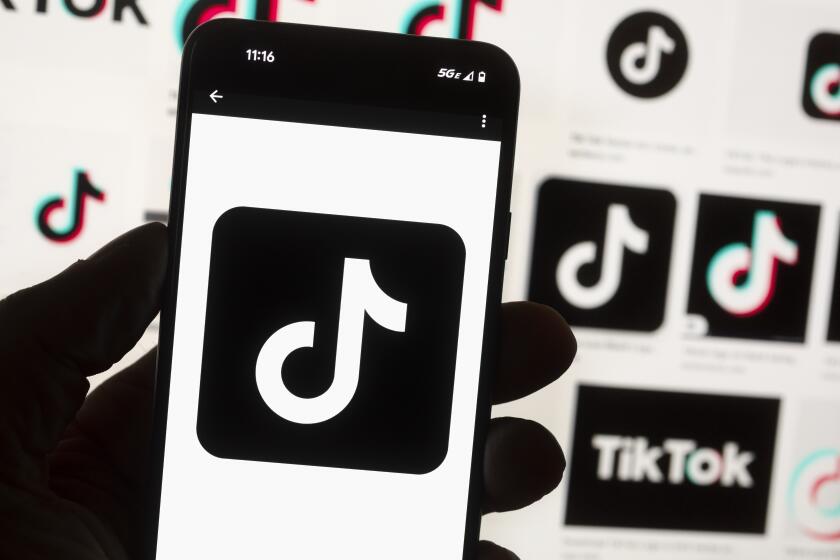Billionaire Patrick Soon-Shiong close to deal to buy the L.A. Times and San Diego Union-Tribune

Los Angeles biotech billionaire Patrick Soon-Shiong is nearing a deal to buy the Los Angeles Times and the San Diego Union-Tribune from their owner, Tronc, according to two people familiar with the talks.
The nearly $500-million cash deal, if consummated, would return The Times to local ownership after 18 years and end a tumultuous relationship with its corporate parent in Chicago. A sale also would represent a major strategy shift for Tronc, which has said that better promoting the Los Angeles Times brand and journalism was a key to its corporate growth.
A deal had not been reached Tuesday afternoon, though both sides were working furiously to complete the transaction and an announcement could come as early as Wednesday, said those sources, who were not authorized to speak about the negotiations publicly and requested anonymity. The sources cautioned that the deal could fall apart at the last minute. Tronc and Soon-Shiong declined to comment.
Tronc is expected to use the $500 million in proceeds to pay down company debt, make other acquisitions and further its digital strategy across the remaining papers, which include the Chicago Tribune, Orlando Sentinel, South Florida Sun-Sentinel and Baltimore Sun. Soon-Shiong would assume pension liabilities for the California News Group, the entity that owns The Times and the Union-Tribune.
The talks accelerated over the weekend after a flurry of news articles questioning Tronc’s oversight of the storied brand and a critical New York Times article that suggested that Los Angeles’ wealthy class had abandoned its hometown newspaper at a time when other billionaires, including Amazon founder Jeff Bezos, had stepped up. Bezos bought the Washington Post in 2013 for $250 million and invested heavily in its newsroom.
Forbes has estimated the net worth of Soon-Shiong, 65, who is the second-largest shareholder of Tronc, at $7.8 billion.
Owning the Los Angeles Times would be a significant coup for Soon-Shiong, one of the city’s wealthiest men, raising his profile in the business, civic and cultural milieu of the nation’s second-largest city. Tronc had rebuffed Soon-Shiong’s repeated efforts to buy The Times as recently as last year, in a public war of words between the doctor and Tronc Chairman Michael Ferro, the company’s largest shareholder.
An excited buzz ran through The Times’ downtown Los Angeles newsroom when the paper confirmed that it was on the verge of being sold. Los Angeles Mayor Eric Garcetti tweeted: “A great city needs a great newspaper, and Los Angeles depends on the @latimes to tell our story every day. I will always be rooting for my hometown paper to succeed.”
“This is surprising,” newspaper analyst Douglas Arthur of Huber Research Partners said. “But it solves several issues by taking care of a disgruntled shareholder, Dr. Soon-Shiong, and also eliminating the Los Angeles Times, which has arguably been a problem child for this management group for years.”

The Times has experienced months of turmoil, starting in August when several top editors were ousted. Ross Levinsohn, a former Yahoo and Fox executive, was appointed its new publisher and brought his own team to develop a new digital strategy. But last month, Levinsohn was placed on unpaid leave pending an investigation into sexual harassment claims that occurred at previous jobs. There have been three top editors in the last six months, including Jim Kirk, who was named editor in chief last week. He replaced former Forbes editor Lewis D’Vorkin, whose tumultuous three-month tenure was marked by contentious dealings with staff members. Also last month, The Times’ newsroom, unhappy with corporate management and years of cost-cutting, overwhelmingly voted to join the News Guild-Communication Workers of America.
The Times’ newsroom has shrunk from more than 1,000 people in the late 1990s to fewer than 400 employees. There have been nine publishers since 1999.
“Unfortunately all of that has taken a toll on one of the greatest journalistic platforms in the U.S. and it has just withered over the last decade,” Arthur said. “Maybe now with invested ownership, and local ownership, things will get better.”
The $500-million purchase price “seems to make sense,” Arthur said, even though it is nearly twice what Bezos paid for the Post.
“The Washington Post was severely challenged by the time Bezos bought it,” Arthur said. “And this is not one but two newspapers.”
Despite ongoing declines in print advertising — print revenue plummeted 17% in the first nine months of 2017 — the company continues to eke out a profit. For the quarter that ended Sept. 30, Tronc reported revenue of $353.1 million, a drop of 6.6% from a year earlier. Net income for the quarter was $2.1 million, compared with a net loss of $10.5 million in the year-earlier period.
Tronc’s market value is $608 million as of market close Tuesday, and the company has about $368 million of debt. A nearly $500-million sale price for the two Southern California papers would represent a little more than half of Tronc’s $972-million enterprise value.
“Patrick Soon-Shiong is a doctor and I hope that he can stand the sight of blood because it is going to take a lot of investment to turn the paper around,” said Gabriel Kahn, a journalism professor at the USC Annenberg School for Communication and Journalism. “The Times has been traded back and forth between owners and been in bankruptcy and there has been no strategic plan or strategic investment in the paper and there is a lot of catching up to do.”
Lloyd Greif, a downtown L.A. investment banker, said he believes Soon-Shiong is interested in acquiring The Times largely for civic reasons, though Greif said he suspects the billionaire entrepreneur will want to get a return on his investment.
“Patrick wants a strong, locally focused, engaged newspaper,” said Greif, who has been closely following the developments but is not involved with the sale. “He wants it to be a vibrant voice. This is 100% good news. But yes, he’s going to make money. He’s not doing this as a charitable gift.”
Greif speculated that Ferro might keep his hometown Chicago Tribune but eventually sell off the rest of the company’s publications.
“This is a sign Ferro is at the end of the road and is prepared to take whatever profit he can get,” Greif said. “So he’ll try to maximize the value of The Times and get what he can for the rest.”
However, a source close to Tronc disputed that speculation, saying there are no plans to sell papers other than the two in Southern California.
Soon-Shiong, a medical entrepreneur and native of South Africa, had been rumored several years ago to be among a group of wealthy Angelenos who were interested in buying The Times. His interest in the paper was formalized in May 2016 when the biotech magnate invested $70.5 million in The Times’ parent company, then called Tribune Publishing and since renamed Tronc Inc., which stands for Tribune Online Content. His current stake is 26%. He also owns a minority stake in the Los Angeles Lakers.
At the time, the deal was seen as a big win for Ferro, a way for him to fight off a hostile takeover bid by rival newspaper company Gannett, which owns USA Today. Though Ferro and Soon-Shiong presented a united front opposed to Gannett, their relationship soon soured.
Early last year, Tronc and Soon-Shiong traded barbs in a series of publicly filed letters, with Soon-Shiong saying he wanted to acquire a larger stake in the company and Tronc saying it had blocked the doctor’s efforts to acquire The Times. An April letter from a Tronc attorney said Soon-Shiong offered to buy The Times in December 2016 but was told he would have to buy all of Tronc — which publishes 10 daily papers. “If [Soon-Shiong] wants to make such a proposal, the board will do its duty and consider it,” Tronc’s attorney wrote.
Ferro initially bought a 16.6% stake in Tribune Publishing in 2016, investing $44.4 million in the company when the stock was trading around $8.50 a share. Ferro has continued to buy shares and now owns a 28% stake. On Tuesday, Tronc shares closed at $18.10.
For more than a century, The Times was owned by the same family. Harrison Gray Otis gained ownership of the paper in 1884 and served as The Times’ publisher until 1917. His descendants, the Chandler family, controlled Times Mirror Co. until its 2000 sale to Chicago-based Tribune Co.
But changes in news consumption began to erode the business, and soon Tribune was under pressure to sell. In 2007, Tribune sold itself to Chicago real estate investor Sam Zell in a costly leveraged buyout that left the company drowning in debt. Within a year, Tribune filed for Chapter 11 bankruptcy protection.
On Dec. 31, 2012, the company emerged from bankruptcy with a consortium of wealthy investors in control. Two years later, the board split the company. One group, Tribune Media, was made up of television stations, real estate holdings — including The Times’ downtown L.A. headquarters — and digital properties. The second company, Tribune Publishing, housed the newspapers, including The Times.
Drama followed. Tribune Publishing’s first chief executive, Jack Griffin, ousted The Times’ publisher, Austin Beutner. Griffin himself was sacked a few months later after he brought in Ferro, a Chicago investor and former owner of the Chicago Sun-Times. Ferro installed Justin Dearborn as CEO, and they renamed the company Tronc. Last summer, Dearborn fired a handful of top Times editors, including the previous publisher/editor, Davan Maharaj. He then hired Levinsohn.
The Times newsroom has been waiting for Tronc to unveil its plan for the papers. One presentation shared with investors included a controversial move to heavily rely on outside contributors to provide articles in an effort to reduce its dependence on the newsroom.
“The Los Angeles Times will never be a national voice the way the New York Times or the Washington Post are, but that’s OK,” USC’s Kahn said. “It can still be the paper of record for California, which has nearly 40 million people, and it can focus on technology, media, agriculture, trade and other big industries, and that will be OK.”
Twitter: @MegJamesLAT
UPDATES:
7 p.m.: This article was updated with additional details and comments.
4:10 p.m.: This article was updated with additional details and comments.
3 p.m.: This article was updated with additional details about the talks.
This article was originally published at 2:45 p.m.
More to Read
Inside the business of entertainment
The Wide Shot brings you news, analysis and insights on everything from streaming wars to production — and what it all means for the future.
You may occasionally receive promotional content from the Los Angeles Times.












